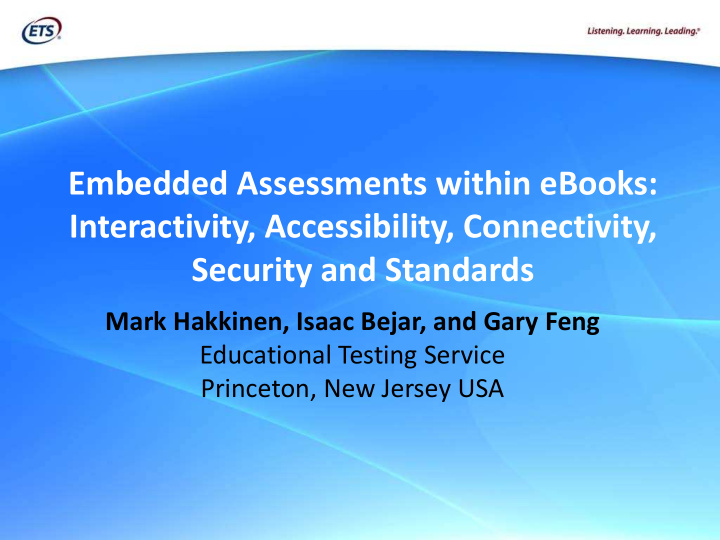



Embedded Assessments within eBooks: Interactivity, Accessibility, Connectivity, Security and Standards Mark Hakkinen, Isaac Bejar, and Gary Feng Educational Testing Service Princeton, New Jersey USA
Themes • Assessments • Interactivity • Accessibility • Connectivity • Security • Standards 2
eTextBooks and Assessment • eTextBooks, whether they be EPUBs, apps, or web content, are here to stay as a platform for delivering learning materials • Combination of EPUB and the Open Web Platform moves the eBook beyond static presentations of print book content to rich, interactive learning experiences 3
• A key aspect of any learning scenario is the assessment of the degree of learning that is taking place • Traditional end of chapter quizzes will be replaced by embedded adaptive assessments • Interactive tasks will not only measure whether concepts are mastered, but can also adapt the presentation of materials to facilitate learning 4
5
6
7
8
Accessibility • The move to interactive content must not compromise or limit accessibility to students with disabilities • Requires support for accessibility at the standards, authoring, and reading system level • Support for accessibility guidelines from W3C, such as WCAG and UAAG • Significant work needed on including math, highly visual content, such as graphics, and simulations 9
10
11
12
13
14
Haptic and Haptic and Audio feedback Audio feedback
Refreshable Braille 16
Connectivity • Connectivity between an eTextBook and external resources – Test item repositories (transformed to HTML5) – Scoring services – School Information Systems – Sharing student progress with parents or teachers, can enhance the learning experience 17
Standards • Standards outside of W3C and IDPF – IMS Global Consortium's APIP, AfA, and QTI will have relevance and potential for collaboration – Common Core State Standards promise to become the lingua franca among educators for discussing student achievement • DIAGRAM Center – Image description 18
Technical Goals for Embedded Assessment • HTML5 • Conformant with W3C Web Content Accessibility Guidelines 2.0 (AA) and other applicable standards • Keyboard, Touch, Speech (TTS/SR) Multi-Modal Interaction • Compatible with Assistive Technologies such as screen readers as well as eReaders/Browsers providing built-in accessibility • Interoperable, cross platform Standards for accessible and interoperable assessments? 19
Recommend
More recommend